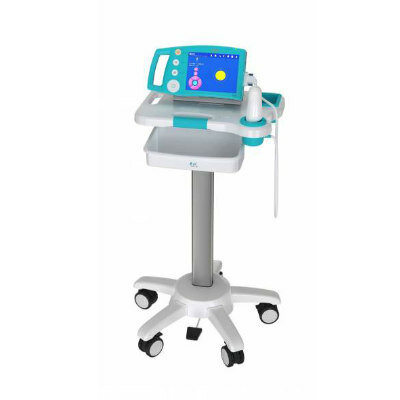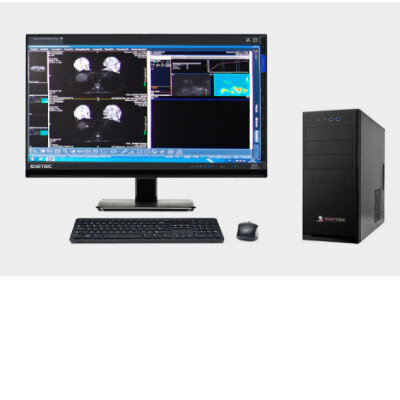AI-Based Biomarker Uses CT Scans to Predict Immunotherapy Response for Lung Cancer Patients
|
By MedImaging International staff writers Posted on 06 Jan 2023 |

Immunotherapy is often the first line of treatment for patients with non-small cell lung cancer, which represents 84% of all lung cancers, according to the American Cancer Society. However, most patients don’t achieve durable results from immune checkpoint inhibitor (ICI) therapies, a type of immunotherapy. In a retrospective study, researchers have now discovered a new artificial intelligence (AI)-derived biomarker that uses routine imaging scans to help predict which patients with lung cancer will respond to immunotherapy. The findings not only offer guidance for patients and their physicians making treatment decisions, but can also curtail the financial burden associated with immunotherapy.
The new biomarker, quantitative vessel tortuosity (QVT), was discovered by a team of researchers from several health care systems and universities, including Emory University (Atlanta, GA, USA), and can influence tumor behavior and therapeutic resistance. Tumors appropriate the body’s machinery for building new blood vessels and redirect as much blood as possible to the tumors so they can grow faster and spread throughout the body. Compared to normal blood vessels, tumor-associated vasculature is chaotically arranged and twisted.
The researchers used AI tools to evaluate different aspects of QVT biomarkers in more than 500 cases of patients with non-small cell lung cancer before and after they were treated with ICI therapies. The researchers discovered that the tumor vasculature of patients who do not respond to ICI therapies is more twisted compared to those who do respond. They hypothesize that blood vessel twistedness causes antitumor cells to accumulate at the tumor site but fail to efficiently infiltrate the tumor, diminishing the effectiveness of immunotherapy. In future work, the researchers will seek to validate QVT biomarkers in prospective clinical trials.
“Immunotherapy only tends to benefit approximately 30% of patients. With the high expense of treatments and a 70% failure rate, we have to find better ways to predict and monitor responses to therapy,” says Anant Madabhushi, PhD, study author and professor in the Wallace H. Coulter Department of Biomedical Engineering at Emory University School of Medicine and Georgia Institute of Technology College of Engineering, and member of the Cancer Immunology research program at Winship Cancer Institute of Emory University. “When making decisions on who to treat and how to treat them, clinicians really need interpretable features. Vessel tortuosity is a novel radiomics method that uses an interpretable and intuitive AI approach to evaluate whether the tumor is responding to therapy even before more obvious changes like tumor size become apparent.”
Related Links:
Emory University
Latest General/Advanced Imaging News
- New AI Method Captures Uncertainty in Medical Images
- CT Coronary Angiography Reduces Need for Invasive Tests to Diagnose Coronary Artery Disease
- Novel Blood Test Could Reduce Need for PET Imaging of Patients with Alzheimer’s
- CT-Based Deep Learning Algorithm Accurately Differentiates Benign From Malignant Vertebral Fractures
- Minimally Invasive Procedure Could Help Patients Avoid Thyroid Surgery
- Self-Driving Mobile C-Arm Reduces Imaging Time during Surgery
- AR Application Turns Medical Scans Into Holograms for Assistance in Surgical Planning
- Imaging Technology Provides Ground-Breaking New Approach for Diagnosing and Treating Bowel Cancer
- CT Coronary Calcium Scoring Predicts Heart Attacks and Strokes
- AI Model Detects 90% of Lymphatic Cancer Cases from PET and CT Images
- Breakthrough Technology Revolutionizes Breast Imaging
- State-Of-The-Art System Enhances Accuracy of Image-Guided Diagnostic and Interventional Procedures
- Catheter-Based Device with New Cardiovascular Imaging Approach Offers Unprecedented View of Dangerous Plaques
- AI Model Draws Maps to Accurately Identify Tumors and Diseases in Medical Images
- AI-Enabled CT System Provides More Accurate and Reliable Imaging Results
- Routine Chest CT Exams Can Identify Patients at Risk for Cardiovascular Disease
Channels
Radiography
view channel
Novel Breast Imaging System Proves As Effective As Mammography
Breast cancer remains the most frequently diagnosed cancer among women. It is projected that one in eight women will be diagnosed with breast cancer during her lifetime, and one in 42 women who turn 50... Read more
AI Assistance Improves Breast-Cancer Screening by Reducing False Positives
Radiologists typically detect one case of cancer for every 200 mammograms reviewed. However, these evaluations often result in false positives, leading to unnecessary patient recalls for additional testing,... Read moreMRI
view channel
PET/MRI Improves Diagnostic Accuracy for Prostate Cancer Patients
The Prostate Imaging Reporting and Data System (PI-RADS) is a five-point scale to assess potential prostate cancer in MR images. PI-RADS category 3 which offers an unclear suggestion of clinically significant... Read more
Next Generation MR-Guided Focused Ultrasound Ushers In Future of Incisionless Neurosurgery
Essential tremor, often called familial, idiopathic, or benign tremor, leads to uncontrollable shaking that significantly affects a person’s life. When traditional medications do not alleviate symptoms,... Read more
Two-Part MRI Scan Detects Prostate Cancer More Quickly without Compromising Diagnostic Quality
Prostate cancer ranks as the most prevalent cancer among men. Over the last decade, the introduction of MRI scans has significantly transformed the diagnosis process, marking the most substantial advancement... Read moreUltrasound
view channel
Deep Learning Advances Super-Resolution Ultrasound Imaging
Ultrasound localization microscopy (ULM) is an advanced imaging technique that offers high-resolution visualization of microvascular structures. It employs microbubbles, FDA-approved contrast agents, injected... Read more
Novel Ultrasound-Launched Targeted Nanoparticle Eliminates Biofilm and Bacterial Infection
Biofilms, formed by bacteria aggregating into dense communities for protection against harsh environmental conditions, are a significant contributor to various infectious diseases. Biofilms frequently... Read moreNuclear Medicine
view channel
New SPECT/CT Technique Could Change Imaging Practices and Increase Patient Access
The development of lead-212 (212Pb)-PSMA–based targeted alpha therapy (TAT) is garnering significant interest in treating patients with metastatic castration-resistant prostate cancer. The imaging of 212Pb,... Read moreNew Radiotheranostic System Detects and Treats Ovarian Cancer Noninvasively
Ovarian cancer is the most lethal gynecological cancer, with less than a 30% five-year survival rate for those diagnosed in late stages. Despite surgery and platinum-based chemotherapy being the standard... Read more
AI System Automatically and Reliably Detects Cardiac Amyloidosis Using Scintigraphy Imaging
Cardiac amyloidosis, a condition characterized by the buildup of abnormal protein deposits (amyloids) in the heart muscle, severely affects heart function and can lead to heart failure or death without... Read moreImaging IT
view channel
New Google Cloud Medical Imaging Suite Makes Imaging Healthcare Data More Accessible
Medical imaging is a critical tool used to diagnose patients, and there are billions of medical images scanned globally each year. Imaging data accounts for about 90% of all healthcare data1 and, until... Read more
Global AI in Medical Diagnostics Market to Be Driven by Demand for Image Recognition in Radiology
The global artificial intelligence (AI) in medical diagnostics market is expanding with early disease detection being one of its key applications and image recognition becoming a compelling consumer proposition... Read moreIndustry News
view channel
Bayer and Google Partner on New AI Product for Radiologists
Medical imaging data comprises around 90% of all healthcare data, and it is a highly complex and rich clinical data modality and serves as a vital tool for diagnosing patients. Each year, billions of medical... Read more





















